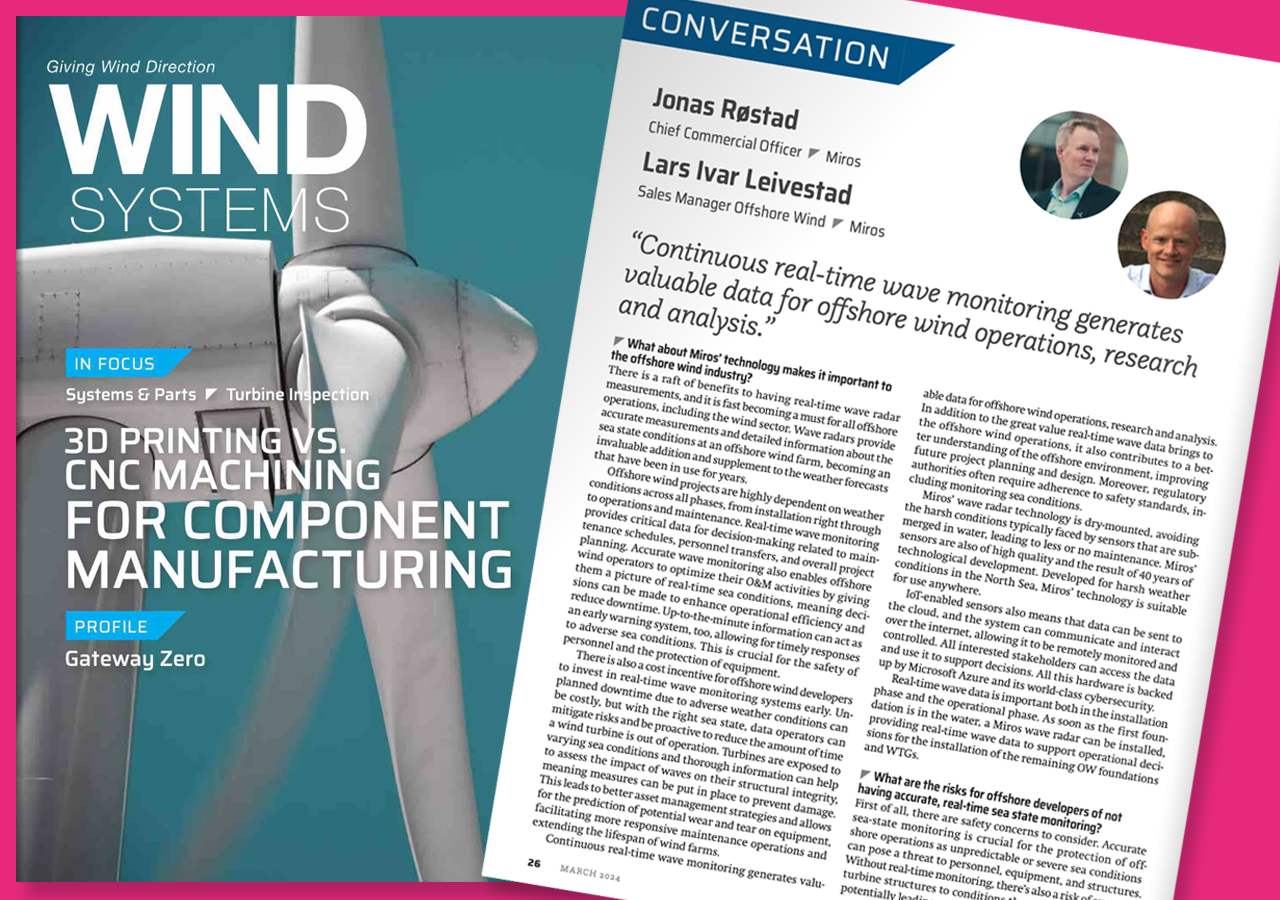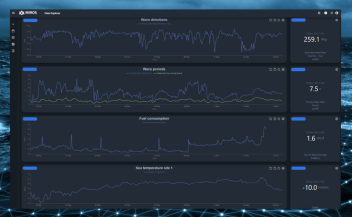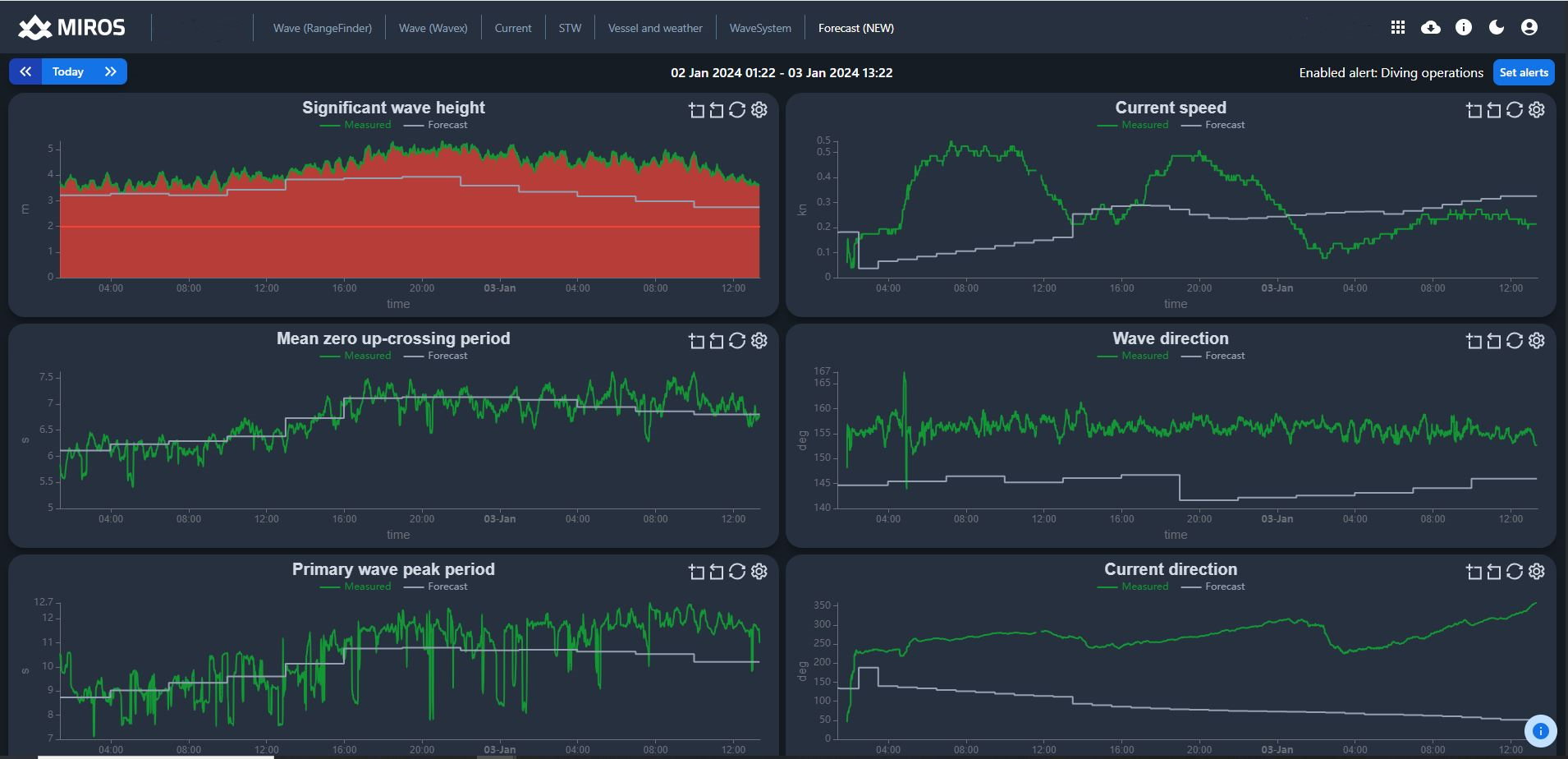Enhance offshore wind operations, research and analysis with continuous real-time wave monitoring
A Conversation with Wind Systems Magazine. Jonas Røstad and Lars Ivar Leivestad discuss Miros’ work with real-time wave radar measurement for offshore operations.




What about Miros’ technology makes it important to the offshore wind industry?
There is a raft of benefits to having real-time wave radar measurements, and it is fast becoming a must for all offshore operations, including the wind sector. Wave radars provide accurate measurements and detailed information about the sea state conditions at an offshore wind farm, becoming an invaluable addition and supplement to the weather forecasts that have been in use for years.
Read the article in Wind Systems Magazine, page 28.
Offshore wind projects are highly dependent on weather conditions across all phases, from installation right through to operations and maintenance. Real-time wave monitoring provides critical data for decision-making related to maintenance schedules, personnel transfers, and overall project planning. Accurate wave monitoring also enables offshore wind operators to optimize their O&M activities by giving them a picture of real-time sea conditions, meaning decisions can be made to enhance operational efficiency and reduce downtime. Up-to-the-minute information can act as an early warning system, too, allowing for timely responses to adverse sea conditions. This is crucial for the safety of personnel and the protection of equipment.
There is also a cost incentive for offshore wind developers to invest in real-time wave monitoring systems early. Unplanned downtime due to adverse weather conditions can be costly, but with the right sea state, data operators can mitigate risks and be proactive to reduce the amount of time a wind turbine is out of operation. Turbines are exposed to varying sea conditions and thorough information can help to assess the impact of waves on their structural integrity, meaning measures can be put in place to prevent damage. This leads to better asset management strategies and allows for the prediction of potential wear and tear on equipment, facilitating more responsive maintenance operations and extending the lifespan of wind farms.
Continuous real-time wave monitoring generates valuable data for offshore wind operations, research and analysis. In addition to the great value real-time wave data brings to the offshore wind operations, it also contributes to a better understanding of the offshore environment, improving future project planning and design. Moreover, regulatory authorities often require adherence to safety standards, including monitoring sea conditions.
Miros’ wave radar technology is dry-mounted, avoiding the harsh conditions typically faced by sensors that are submerged in water, leading to less or no maintenance. Miros’ sensors are also of high quality and the result of 40 years of technological development. Developed for harsh weather conditions in the North Sea, Miros’ technology is suitable for use anywhere.
IoT-enabled sensors also means that data can be sent to the cloud, and the system can communicate and interact over the internet, allowing it to be remotely monitored and controlled. All interested stakeholders can access the data and use it to support decisions. All this hardware is backed up by Microsoft Azure and its world-class cybersecurity.
Real-time wave data is important both in the installation phase and the operational phase. As soon as the first foundation is in the water, a Miros wave radar can be installed, providing real-time wave data to support operational decisions for the installation of the remaining OW foundations and WTGs.
What are the risks for offshore developers of not having accurate, real-time sea state monitoring?
First of all, there are safety concerns to consider. Accurate sea-state monitoring is crucial for the protection of offshore operations as unpredictable or severe sea conditions can pose a threat to personnel, equipment, and structures. Without real-time monitoring, there’s also a risk of exposing turbine structures to conditions they are not designed for, potentially leading to structural damage or failure.
Weather and sea state can change quickly and can disrupt offshore operations. For example, high waves or rough seas may hinder the transfer of personnel, equipment, or supplies, affecting project timelines and productivity. Wind turbines and other offshore equipment, such as cranes or gangways used for walk-to-work operations, may also be susceptible to damage in adverse sea conditions. Real-time monitoring allows for timely adjustments or shutdowns to prevent equipment damage.
More broadly, without real-time sea-state information vessel navigation becomes more challenging, increasing the risk of collisions, groundings, or other accidents. Moreover, if operators base their operational windows on weather forecast and not on accurate real-time measurements, operations can be stopped earlier or later than necessary. If stopped earlier, it can result in project delays and affect the overall budget. If they are stopped too late, you risk exposing personnel and equipment to unnecessary threats. Also, when starting operations after weather down time, real-time measurements will be an objective decision for when operations can start up again.
What is the “as-a-Service” business model, and what are the benefits to offshore wind operators?
By subscribing to Miros’ technology, rather than buying it outright, clients receive premium support and guaranteed uptime inclusive, increasing the operational output of wind turbines. Under as-a-Service, an advantageous sensor warranty, and the latest Microsoft Azure cybersecurity are included as a standard. If any matters or questions arise, Miros experts are ready to address them.
Should any barriers occur, we usually solve them quickest remotely; in the rare case that is not possible, we’ll send an expert to do the job in person. However, if a client decides to solely buy hardware from us or any other competing brands without a cloud subscription, they will also need to manage any hiccups themselves or send the equipment for repair. That takes more time and might have a significant impact on the operations and safety of their asset. Also, if we own and monitor the equipment, we make sure that it is future-proof. We will regularly upgrade the software remotely, so it always holds the highest standards. That way, it will not become outdated as technology progresses, and performance interruptions will be avoided.
Then there are co-creation and the ability for multiple users to benefit from the same interface. Measurements from the wave radars are sent right to the cloud, meaning they can be viewed wherever and whenever on any device, and shared with other companies that are working on the wind farm. Having this first-hand access to both the technology and the data, we facilitate a close and powerful cooperation with our customers that allows us to continuously improve the applications as well as immediately take necessary measures should any data irregularities be spotted.
What trends do you anticipate being important for wave measurements in 2024?
Wave Prediction is high on the agenda for many offshore vessel owners and operators. Knowing the waves and the corresponding vessel movement up to two minutes ahead of time will help to ensure safer operations and optimal timing for operations such as crew transfers, cable laying, anchor handling, etc. Miros’ wave prediction is developed and tested in cooperation with key customers and the initial results are very promising.
The use of multiple wave sensors at offshore wind farms for optimizing O&M operations and enhancing safety will also continue to increase. Many of the wind farms currently going into the operational phase, as well as those that have been spinning for many years, will start to look at how they can optimize their maintenance scheduling and operations. Miros’ WaveFusion is already well received by the offshore wind market and more and more companies see the benefits of this sensor in combination with the as-a-Service business model. Miros ensures high quality and accurate wave data is sent to the cloud and is accessible by all the customer’s stakeholders, anywhere and on any device, further assisting the planning and delivery of O&M operations.
Full scale floating offshore wind farms will soon become a reality with multiple projects in the pipelines. These wind farms will, in most cases, be located further offshore, where there is more variability in weather, rougher conditions, and more storms. Operators will need a better understanding of the changing weather conditions, which means even more accurate data and more measurement points will be needed at wind farms. There will also be a need for wave monitoring to ensure the safety of the assets in high seas. The automatic shutdown of the turbines solely based on wind speed is no longer sufficient, platform movements will also be important and must be taken into consideration when asset safeguarding systems are developed.
What about Miros’ technology makes it important to the offshore wind industry?

See live measurements on miros.app.
There is a raft of benefits to having real-time wave radar measurements, and it is fast becoming a must for all offshore operations, including the wind sector. Wave radars provide accurate measurements and detailed information about the sea state conditions at an offshore wind farm, becoming an invaluable addition and supplement to the weather forecasts that have been in use for years.
Offshore wind projects are highly dependent on weather conditions across all phases, from installation right through to operations and maintenance. Real-time wave monitoring provides critical data for decision-making related to maintenance schedules, personnel transfers, and overall project planning. Accurate wave monitoring also enables offshore wind operators to optimize their O&M activities by giving them a picture of real-time sea conditions, meaning decisions can be made to enhance operational efficiency and reduce downtime. Up-to-the-minute information can act as an early warning system, too, allowing for timely responses to adverse sea conditions. This is crucial for the safety of personnel and the protection of equipment.
There is also a cost incentive for offshore wind developers to invest in real-time wave monitoring systems early. Unplanned downtime due to adverse weather conditions can be costly, but with the right sea state, data operators can mitigate risks and be proactive to reduce the amount of time a wind turbine is out of operation. Turbines are exposed to varying sea conditions and thorough information can help to assess the impact of waves on their structural integrity, meaning measures can be put in place to prevent damage. This leads to better asset management strategies and allows for the prediction of potential wear and tear on equipment, facilitating more responsive maintenance operations and extending the lifespan of wind farms.
Continuous real-time wave monitoring generates valuable data for offshore wind operations, research and analysis. In addition to the great value real-time wave data brings to the offshore wind operations, it also contributes to a better understanding of the offshore environment, improving future project planning and design. Moreover, regulatory authorities often require adherence to safety standards, including monitoring sea conditions.
Miros’ wave radar technology is dry-mounted, avoiding the harsh conditions typically faced by sensors that are submerged in water, leading to less or no maintenance. Miros’ sensors are also of high quality and the result of 40 years of technological development. Developed for harsh weather conditions in the North Sea, Miros’ technology is suitable for use anywhere.
IoT-enabled sensors also means that data can be sent to the cloud, and the system can communicate and interact over the internet, allowing it to be remotely monitored and controlled. All interested stakeholders can access the data and use it to support decisions. All this hardware is backed up by Microsoft Azure and its world-class cybersecurity.
Real-time wave data is important both in the installation phase and the operational phase. As soon as the first foundation is in the water, a Miros wave radar can be installed, providing real-time wave data to support operational decisions for the installation of the remaining OW foundations and WTGs.
Read the article in Wind Systems Magazine, page 28.
How does Miros collaborate with its customers to provide its solutions?
Miros consistently works with its customers to address their challenges. We engage in close partnerships with numerous clients to ensure that we create solutions tailored to their specific needs, rather than presuming what they might require. This can involve modifying existing products and adapting solutions for new applications, continually expanding our product portfolio, and developing innovative solutions. Our goal is to support our customers in operating safely and efficiently at sea.
What technologies are Miros developing to further support operators’ understanding of the offshore environment?
Wave prediction is one of Miros’ latest developments, and it involves forecasting the behavior of ocean waves over a specific period. Utilizing accurate wave radar data, this process provides valuable information for maritime activities and offshore operations, aiding in decision-making for safety and efficiency at sea.
Miros Heading Advisor is a navigation tool designed to provide guidance on the optimal heading or direction for vessels. It assists marine operators in making informed decisions to navigate efficiently, avoid obstacles, and reach their destinations safely. This technology incorporates Miros’ real-time wave data, weather conditions, and navigational parameters to offer accurate heading recommendations for improved maritime operations.
Recently launched, Miros Forecast is an indispensable application where the ocean condition forecast vs. measured real-time conditions is visualized in an easy and intuitive dashboard in Miros Cloud. The application helps to elevate maritime safety and operational efficiency due to the integration of forecasts with real-time measured ocean data. In the ever-evolving landscape of maritime and offshore operations, staying vigilant and ahead of environmental conditions is paramount for ensuring safety, efficiency, and cost-effectiveness. With Forecast, you get forecasted ocean-state data together with real-time measured data integrated into the easy and intuitive Miros Cloud dashboard.
Marine Operations teams can make data-led decisions by leveraging both forecast and real-time data in one simple dashboard. Enhanced by visual alarms, operations teams can stay up-to-date when specific wave conditions surpass predefined limits keeping the operations safe and efficient. Real-time measurements combined with forecast data empower site managers to optimize the site efficiently. This optimization extends to various offshore activities on vessels, platforms, wind-farm ports, and coastlines, ultimately enhancing the ability to meet the project targets and within the regulatory safety policies. We are also working to assist control room operators in the continuous assessment of both real-time and forecasted wave and weather data, enabling them to dynamically adjust their strategies.
Miros Forecast is also beneficial for diving and ROV technicians. In the challenging conditions of high seas with substantial waves, potential risks to ROVs are significant, particularly during deployment, maneuvering, or retrieval. Having precise information about both current and forecasted sea states empowers technicians to make well-informed decisions.

